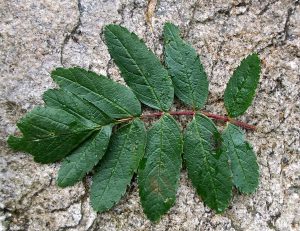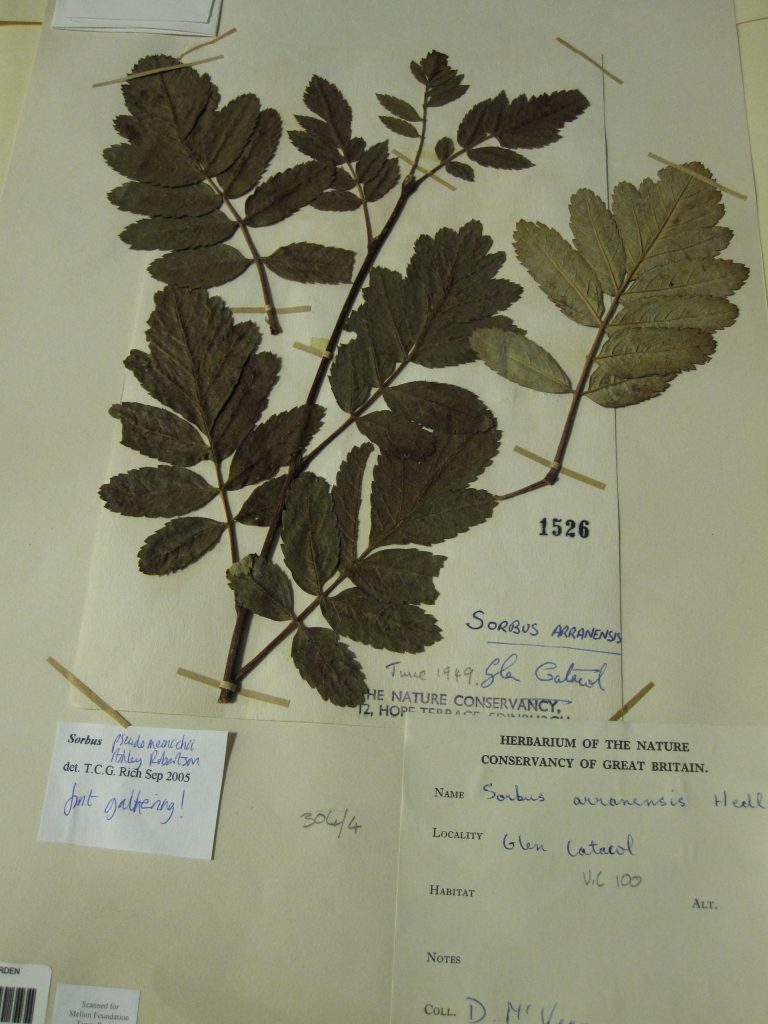
Leaf of Catacol whitebeam (Sorbus pseudomeinichii) showing the distinctive enlarged terminal leaflet.
The trees planted adjacent to the coffee shop at the East Gate Lodge include three species found only on Arran on the west coast of Scotland. The origin of these trees lies in the shocking idea of sex between different species (quite unremarkable to botanists who see plant hybrids as perfectly normal). All three of the unique Arran trees are in the genus Sorbus and trace their origins back to crosses between the more widespread rowan (Sorbus aucuparia) and rock whitebeam (Sorbus rupicola). Quite why this cross-species promiscuity has taken place on Arran and not (as far as we known) in other British sites where both species grow is something of a mystery. Similar crosses have been recorded in Scandinavia, but these species do not exactly match the Arran trees so each has been given its own name.
The story of the discovery of these unique trees spans the whole of the 20th century and begins with the Swedish botanist Johan Hedlund. In 1901 Hedlund published details of two new Sorbus species: Sorbus meinichii from the area around Moster in Norway, and Sorbus arranensis which, as the name indicates, hails from Arran. The uniqueness of the Arran trees had been noted prior to this although they were mistakenly placed in the genus Pyrus, better known as pears. In 1957 Edmund Warburg, one of three botanists who wrote the definitive book on British plants at that time (Flora of the British Isles), described a second species unique to Arran and called it Sorbus pseudofennica to indicate the similarity to a Sorbus species already known from Finland. So by the mid-twentieth century we had Arran whitebeam (Sorbus arranensis) and Arran service-tree (Sorbus pseudofennica).

The original 1949 McVean specimen of Catacol whitebeam with annotations indicating it to be the ‘first gathering.’
The final chapter of this story involves the discovery and eventual description of the third Arran Sorbus. It is a surprisingly common occurance for a new species to be collected but not recognised as new. Such species languish in collections unidentified or misidentified. This was the initial fate of what would eventually be called the Catacol whitebeam (Sorbus pseudomeinichii).
In June 1949 Scottish botanist and ecologist Donald McVean collected a Sorbus in Glen Catacol that was misidentified as Arran whitebeam. Around the millennium RBGE botanist Phil Lusby saw McVean’s specimen and instantly knew it was something new and interesting. He strongly suspected it was a hybrid between Arran service-tree and rowan. The species of Sorbus on Arran are told apart by the form of their leaves and the McVean specimen had a leaf very much like rowan, composed of leaflets, but differing in the larger terminal leaflet.
Even though this specimen was of great interest, tracking it down was going to prove a challenge as the location was simply given as Glen Catacol, Arran. By extraordinary good fortune Phil subsequently found a tree that matched the McVean specimen. Phil told me he had been leaning on a tree and suddenly realised it had the distinctive enlarged terminal leaflet.
At that time Ashley Robertson had just begun a Ph.D. on Sorbus and his examination of the genetics of this unusual tree proved beyond doubt that it was the result of a cross between Arran service-tree (Sorbus pseudofennica) and rowan (Sorbus aucuparia). In 2006 Ashley published Sorbus pseudomeinichii as a new species and it arguably became Scotland’s rarest tree. As far as we know there is only a single individual growing wild on Arran. A second small tree found near the first tree subsequently vanished. The name chosen for this species reflects the similarity to Hedlund’s Sorbus meinichii from a century earlier.
To conserve this very rare species the Garden has germinated seed (with limited success) and grafted material onto the roots of ordinary rowan. As a result the Catacol whitebeam has entered the collections of botanic gardens and it’s future is now secure. As the one wild tree is in a ravine created by an upland stream it is quite possible that it will be swept away in a winter flood.
As a postscript you might be wondering how it is that hybrid trees can be recognised as species in their own right? Surely the Arran species would either not reproduce or fail to remain stable from one generation to the next. The reason they do remain stable is that the trees clone themselves via seed that is produced with no genetic contribution from the pollen (the male parent). After the sex required to produce the hybrid in the first place it then reproduces itself faithfully with virtually no further genetic change. The technical term for this is agamospermy which translates as “asexual seeds.” This trick is something that the Arran species have inherited from rock whitebeam, one of the original species involved in setting off this curious example of evolution through hybridisation.

tracey hamston
Hi, I study Sorbus with a focus on the species found in the SW of the UK, see http://wp.me/p4sx8O-77s I’m interested in your Sorbus pseudomeinichii in the gardens and wonder how seed production compares with the in situ trees but also whether you have propagated from garden produced seed.
I recently visited the gardens and enjoyed seeing the Scottish Sorbus!
Tracey
Max Coleman
Hi Tracy, I wrote the blog and am pleased that you found it of interest. I did collect some berries from the S. pseudomeinichii near the East Gate last autumn and found that out of around 10 berries I only got three seeds that seemed to have developed properly. So it seems that most berries are failing to develop for some reason. There are other Sorbus nearby so I doubt that this is due to lack of pollen (I understand that pollen is still needed even though this is an apomictic species). There was some collection of berries from the wild made a few years back and those berries also gave poor results.I think only a single seedling was produced!
Max
tracey hamston
that’s interesting. I have made a few collections myself and grown on quite a number of the Devon locals! but always have had great difficulty with the triploid species – which I believe Sorbus pseudomeinichii is.
Although there are exceptions so I suspect some are just better seed producers than others. Probably why some exist in such low numbers in the wild.
Did all your seeds come true? We have had some strange results in the gardens!
Thanks for your reply and I hope to visit Edinburgh again soon
Tracey
x
(as far as we known)
just pointing out a typo.
excellent article, and fascinating info. prior to propagation, was the wild Sorbus pseudomeinichii the only known individual of its species in the world, then?
julian lusby
hi Phil just a general comment, I have just discovered your numerous papers on species such as the Oblong Woodsia and the Catacol whitebeam to name just two…..I look forward to many days of exploration online to further my knowledge…..many thanks Julian
Max Coleman
Hi Julian,
Thanks for your interest in the Arran Sorbus blog I wrote. I’ll let Phil know you found the story interesting.
Regards,
Max